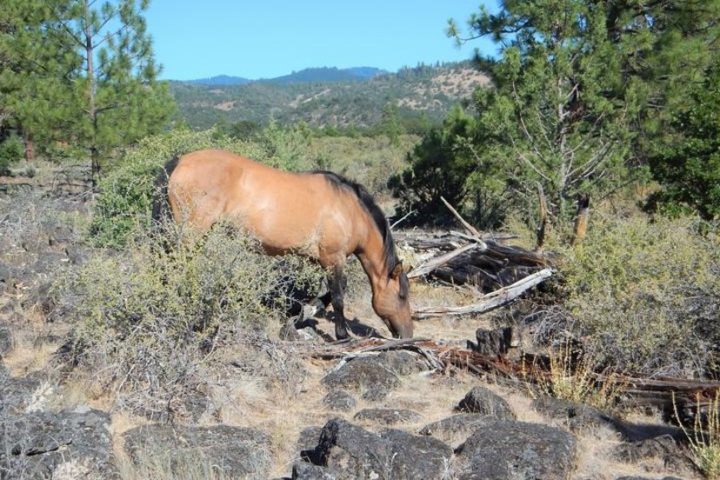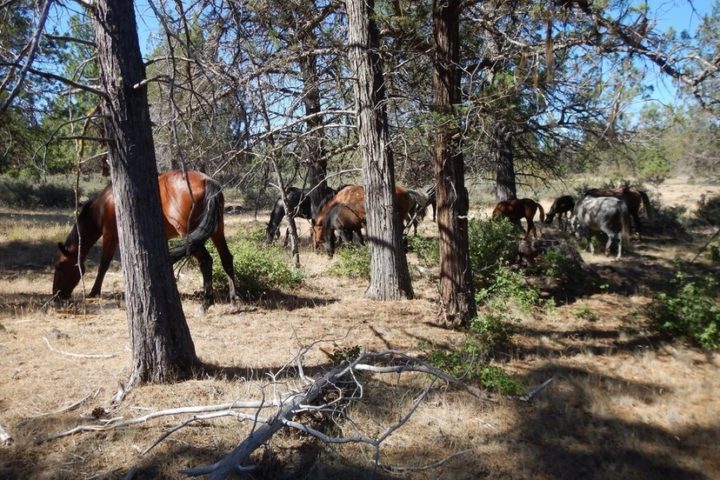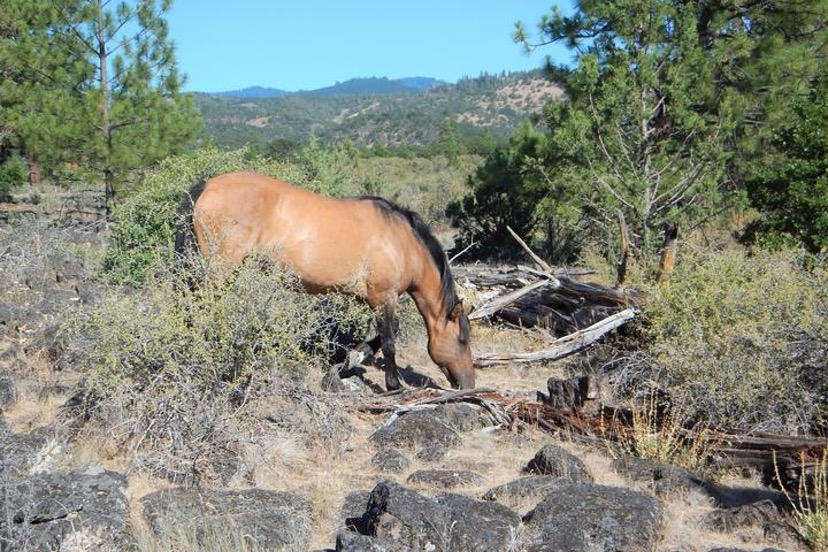Only a tiny minority of Americans want to see American wild horses sent to slaughter to make room for more livestock grazing on public lands.
Obviously, we don’t see most Americans giving up their hamburgers and steaks, so the demands for beef, lamb and pork are slowly increasing. But do we need to kill wild horses in slaughter houses?
And is this even a wise use of these publicly-owned wild horses?
The Questions of Value Arise
Are wild horses more valuable in a pet food can and/or sitting in exile, wasting away in a Bureau of Land Management off-range corral costing American taxpayers nearly $100-million per year? Is there a much higher value proposition that’s been overlooked?
What about the undeniable billion-dollar economics of using wild horses in a wildfire fuel abatement role — protecting human lives, assets, forest and timber resources, as well as other tertiary benefits?
Since the codification of the 1971 Free-Roaming Wild Burro and Horse Protection Act five decades ago, there have been many profound breakthroughs and discoveries in science. For instance, modern paleontology informs us that wild horses have successfully maintained habitats in virtually every biome on the planet ranging from sub-arctic to tropical.
We also now know that wild horses survived the Ice Age in forests, as we read here in Cosmos magazine.
Given recently discovered facts, as far as equine genetics (including epigenetics), paleontological ecology (habitats and ranges of wild equids based-on fossil records), and through the cultural archaeology of native Americans and their horses, which arguably pre-date the Columbian Period, would planners today draw the same lines on maps defining areas for wild horses under any new law for their protection?
I seriously doubt it. Comparing what we know today, to what we knew in the 1960s and in early 1971, it’s clear we knew very little about wild horses, as well as their history and ecology.
And even by today’s standards, we still have much to learn in many areas. Scant funding is provided for the study of American wild horses in comparison to studies related to livestock.
In a world where we have more people than ever wanting more resources than ever before, financial considerations must not be discounted.

What is the real value of an American wild horse?
I would respond, to those with love in their hearts; the sum is beyond quantification.
To those who render meat? An 800-pound horse is worth about $160.00 (20-cents per pound wholesale).
To those who have knowledge of recent scientific facts and vision; each wild horse is worth at least $72,000.00.
Why Each American Wild Horse Is Worth About $72,000
Each wild horse deployed into and around remote forest and wilderness areas with depleted deer populations can abate 5.5 tons of wildfire fuels (grass and brush) annually — about 30 pounds/day/horse.
As an evolved North American native species, wild horses are quite at-home in and around forests and areas that are virtually inaccessible, especially wilderness areas.
For comparison, on average, deer consume about 7 pounds of grass and brush per day, per animal. Many remote wilderness areas are poorly suited to commercial livestock grazing due to the extensive predation of calves and lambs, and logistics cost related to poor accessibility and very difficult terrain.
These and other factors significantly reduce profitability to livestock producers who use public lands grazing permits. Losing calves and lambs is not an option of livestock production.
And at least in wilderness areas, depleting all of the Apex Predators is unwise, and is what has led to the spread of Chronic Wasting Disease.
Apex predators have evolved with unique skills that allow them to quickly cull and sick or genetically weak animals from the populations of large and small herbivores. Their predation as it turns-out is vital in preventing deer sick with Chronic Wasting Disease from remaining among populations of healthy deer and spreading the disease. Predators quickly cull diseased deer and elk and that helps to prevent the spread of that deadly disease.
Western forests are depleted of deer due to poor wildlife management. California and Oregon are down over 2 million deer over the past five decades even as Chronic Wasting Disease is spreading, and is now in at least 27 states. These now missing deer had been abating nearly 3 million tons of grass and brush. It will take decades to correct our depleted deer populations.
A re-wilded American wild horse, which is resistant to Chronic Wasting Disease, will abate about 5.5 tons of prodigious grass and brush annually in and around forests. 5.5 tons of grass and brush equals roughly 5-7 acres of grass and brush (varies with area), which can easily be maintained by wild horses year-round at nominal levels without any human intervention or the added risk of man-caused wildfires, especially during summer.
The Value Of Wildfire Reduction By American Wild Horses
According to Science Magazine:
By altering the quantity and distribution of fuel supplies, large herbivores can shape the frequency, intensity, and spatial distribution of fires across a landscape. There are even unique interactions among large herbivore populations that can influence fire regimes.
In order to accomplish the same task of deployed wild horses in the mitigation of prodigious grass and brush levels in areas of remote and difficult wilderness terrain, it would require 2-men about 4-5 weeks of work, using hand tools, according to at least one article.
It is important to note that motorized equipment and methods are by law prohibited in wilderness areas, as well as impractical due to rugged terrain.
Each human laborer requires a minimum wage of about $15.00/hour, which equals $120/day/laborer, or $240.00 per day for two men. This ($240.00/day) is multiplied by the minimum of 4-weeks (20-work days), which equals about $4,800.00 in cost, which is comparable to the effect of one American wild horse grazing for one-year.
There are also human resource issues involved with this method, which add more costs. So, using man-power, we arrive at a per-acre-cost for grass and brush abatement of $685.71 per acre. This is based upon the greatest average efficiency ($4,800.00 divided by 7-acres treated).
Now, we look at the comparative costs of using wildlife (wild horses) to do the same job:
An American wild horse abates excess grass and brush fuel from wildfires on the same 7-acres virtually at no cost to taxpayers.
In wilderness areas, this is critically important since virtually all traditional fuel treatment method used by the USFS and other agencies are prohibited, with good reason.
According to the USFS, even in areas where their most cost-effective method fuel treatment is allowed, which is prescribed burning; the cost to taxpayers for that is $400.00 per acre and more.
The western landscape has tens-of-millions of acres that have annually recurring grass and brush wildfire fuels.

Prescribed Burning — A Terrible Prescription For Controlling Wildfire Fuels
Based upon the best recent science related to the health and welfare of humans and wildlife, ‘prescribed burning’ is a terrible prescription for the control of annual grass and brush wildfire fuels.
Like wildfires, so-called ‘prescribed burns’ release millions of tons of toxic compounds as a part of the composition of the smoke that is released into the air. And some wildlife, especially reptiles, amphibians and ground birds are overcome and killed by the smoke and heat. Further still, some prescribed burns get out of control and become uncontrolled wildfires, as we have seen in past situations, destroying hundreds of homes.
An American wild horse will live about 15-20 years in a wilderness environment and has no human resource issues; they don’t need management or pay-checks; they don’t sue anyone and they don’t start fires.
Each American wild horse deployed into a wilderness wildfire fuels maintenance role will yield about $72,000.00 in work value over its life ($4,800 each year X 15 years).
The value of a wild horse in a wildfire fuels mitigation roll is a multiple of 450-times the value of the same horse rendered as meat.
It’s clearly obtuse to even consider using wild horses for slaughter given that on top of the $72,000.00, there is added value to that outlined above in regard to the savings to taxpayers in firefighting costs, increased insurance costs, value of natural resources lost, increase health costs from smoke, loss of economic value in communities due to fire damage to properties leading to loss of tax role values, etc.
Furthermore, having evolved on the North American continent 55 million years ago, wild horses have documented symbiotic mutualisms with both forest and soils ecosystems that invasive species — cattle and sheep — do not have as ruminants.
Wild horses are monogastric digestors (single stomach) and pass both humus and viable native plant seeds back onto the soils they graze, which restores fire-damages soils and allows the evolved symbiotic re-seeding of native plants; critical to the survival of native flora and the fauna dependent on the native flora.
Furthermore, the ecologically-sound wildfire grazing by native species American wild horses sequesters carbon compounds back into soils. Wildfires and prescribed burns volatilize these compounds into our air and atmosphere, further accelerating climate change…
The Good News!
We have a ready-made solution via a draft outline for a legislative bill that could save American taxpayers billions of dollars annually! That draft as well as other information can be found at www.WHFB.us
William E. Simpson II is a naturalist, author, and conservationist living in the Soda Mountain wilderness area among the wild horses that he studies. Learn more at Wild Horse Fire Brigade.

